Issues in Auditing: Financial Statement Analysis Report
VerifiedAdded on 2020/05/11
|16
|3256
|54
Report
AI Summary
This report delves into the critical aspects of auditing, commencing with the planning phase, which is essential for successful audit execution. It then explores analytical review procedures, comparing financial statement items to identify relationships and trends. The report emphasizes the importance of preliminary judgment of materiality, illustrating how auditors assess the significance of misstatements. It proceeds to analyze specific accounts, including consultancy fees, bank charges, interest income, sales, depreciation, cost of sales, and superannuation, providing rationale for selection, key assertions, and recommended audit procedures for each. The analysis includes percentage changes, materiality assessments, and detailed audit steps to ensure the accuracy and reliability of financial statements. References and an appendix are included to support the findings.
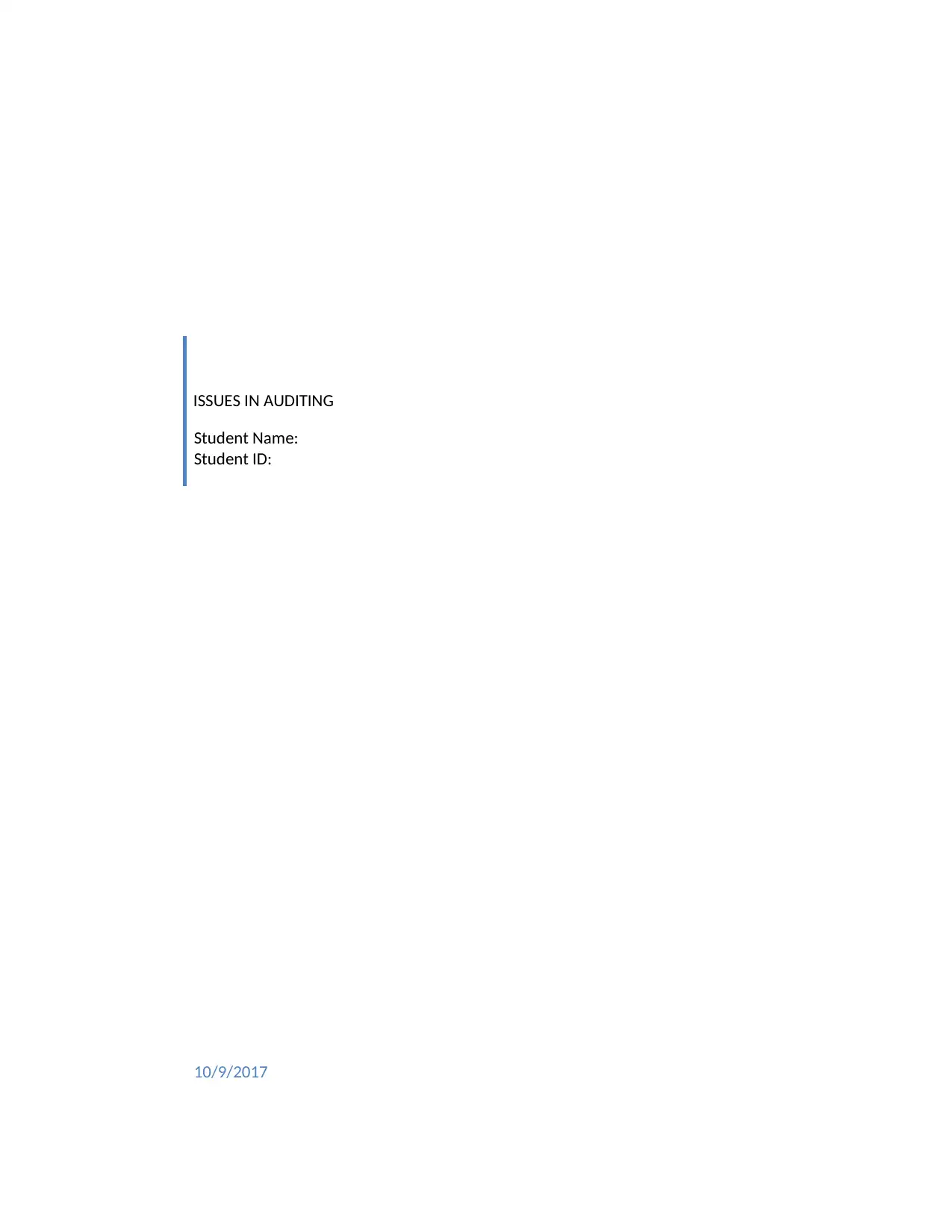
ISSUES IN AUDITING
Student Name:
Student ID:
10/9/2017
Student Name:
Student ID:
10/9/2017
Paraphrase This Document
Need a fresh take? Get an instant paraphrase of this document with our AI Paraphraser
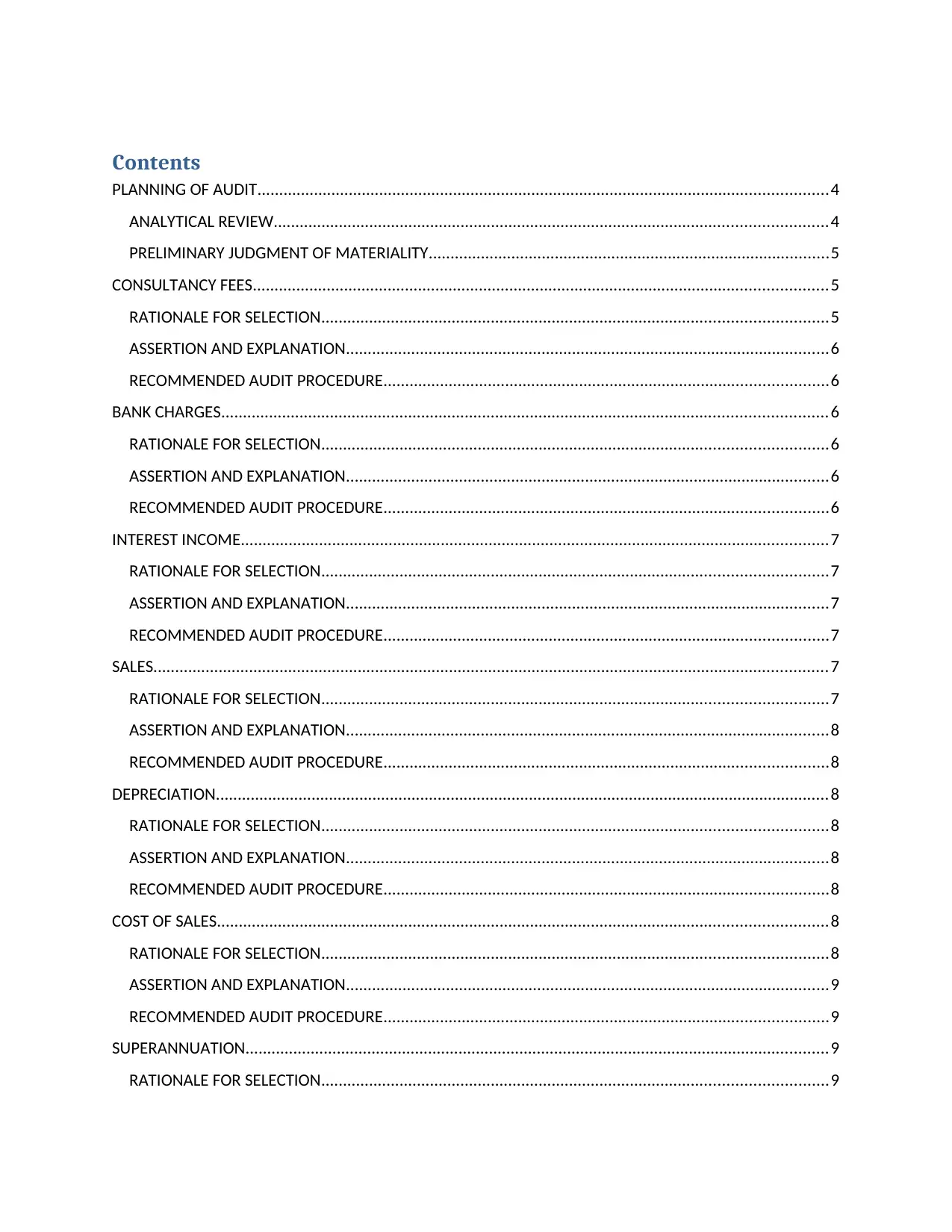
Contents
PLANNING OF AUDIT...................................................................................................................................4
ANALYTICAL REVIEW...............................................................................................................................4
PRELIMINARY JUDGMENT OF MATERIALITY............................................................................................5
CONSULTANCY FEES....................................................................................................................................5
RATIONALE FOR SELECTION....................................................................................................................5
ASSERTION AND EXPLANATION...............................................................................................................6
RECOMMENDED AUDIT PROCEDURE......................................................................................................6
BANK CHARGES...........................................................................................................................................6
RATIONALE FOR SELECTION....................................................................................................................6
ASSERTION AND EXPLANATION...............................................................................................................6
RECOMMENDED AUDIT PROCEDURE......................................................................................................6
INTEREST INCOME.......................................................................................................................................7
RATIONALE FOR SELECTION....................................................................................................................7
ASSERTION AND EXPLANATION...............................................................................................................7
RECOMMENDED AUDIT PROCEDURE......................................................................................................7
SALES...........................................................................................................................................................7
RATIONALE FOR SELECTION....................................................................................................................7
ASSERTION AND EXPLANATION...............................................................................................................8
RECOMMENDED AUDIT PROCEDURE......................................................................................................8
DEPRECIATION.............................................................................................................................................8
RATIONALE FOR SELECTION....................................................................................................................8
ASSERTION AND EXPLANATION...............................................................................................................8
RECOMMENDED AUDIT PROCEDURE......................................................................................................8
COST OF SALES............................................................................................................................................8
RATIONALE FOR SELECTION....................................................................................................................8
ASSERTION AND EXPLANATION...............................................................................................................9
RECOMMENDED AUDIT PROCEDURE......................................................................................................9
SUPERANNUATION......................................................................................................................................9
RATIONALE FOR SELECTION....................................................................................................................9
PLANNING OF AUDIT...................................................................................................................................4
ANALYTICAL REVIEW...............................................................................................................................4
PRELIMINARY JUDGMENT OF MATERIALITY............................................................................................5
CONSULTANCY FEES....................................................................................................................................5
RATIONALE FOR SELECTION....................................................................................................................5
ASSERTION AND EXPLANATION...............................................................................................................6
RECOMMENDED AUDIT PROCEDURE......................................................................................................6
BANK CHARGES...........................................................................................................................................6
RATIONALE FOR SELECTION....................................................................................................................6
ASSERTION AND EXPLANATION...............................................................................................................6
RECOMMENDED AUDIT PROCEDURE......................................................................................................6
INTEREST INCOME.......................................................................................................................................7
RATIONALE FOR SELECTION....................................................................................................................7
ASSERTION AND EXPLANATION...............................................................................................................7
RECOMMENDED AUDIT PROCEDURE......................................................................................................7
SALES...........................................................................................................................................................7
RATIONALE FOR SELECTION....................................................................................................................7
ASSERTION AND EXPLANATION...............................................................................................................8
RECOMMENDED AUDIT PROCEDURE......................................................................................................8
DEPRECIATION.............................................................................................................................................8
RATIONALE FOR SELECTION....................................................................................................................8
ASSERTION AND EXPLANATION...............................................................................................................8
RECOMMENDED AUDIT PROCEDURE......................................................................................................8
COST OF SALES............................................................................................................................................8
RATIONALE FOR SELECTION....................................................................................................................8
ASSERTION AND EXPLANATION...............................................................................................................9
RECOMMENDED AUDIT PROCEDURE......................................................................................................9
SUPERANNUATION......................................................................................................................................9
RATIONALE FOR SELECTION....................................................................................................................9
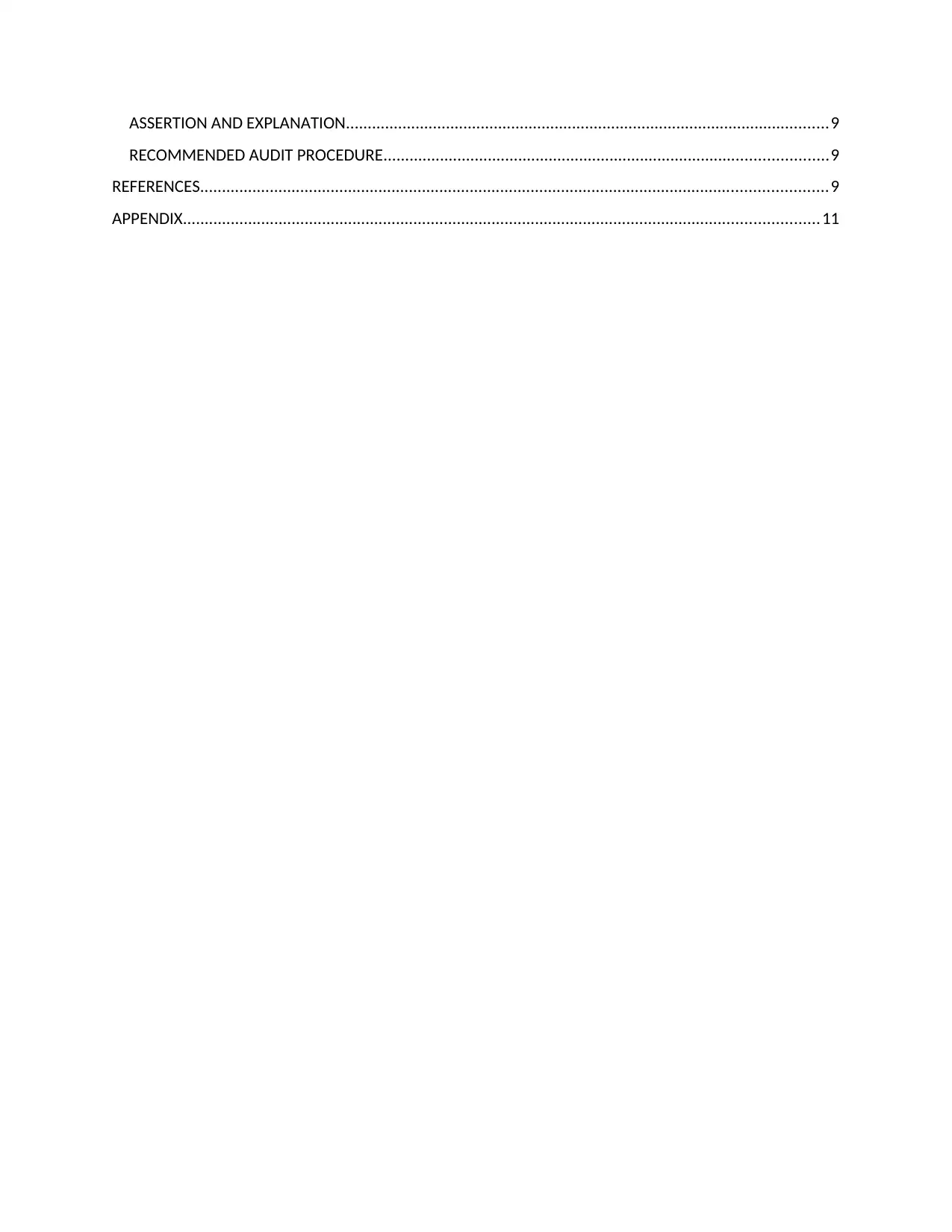
ASSERTION AND EXPLANATION...............................................................................................................9
RECOMMENDED AUDIT PROCEDURE......................................................................................................9
REFERENCES................................................................................................................................................9
APPENDIX..................................................................................................................................................11
RECOMMENDED AUDIT PROCEDURE......................................................................................................9
REFERENCES................................................................................................................................................9
APPENDIX..................................................................................................................................................11
⊘ This is a preview!⊘
Do you want full access?
Subscribe today to unlock all pages.

Trusted by 1+ million students worldwide
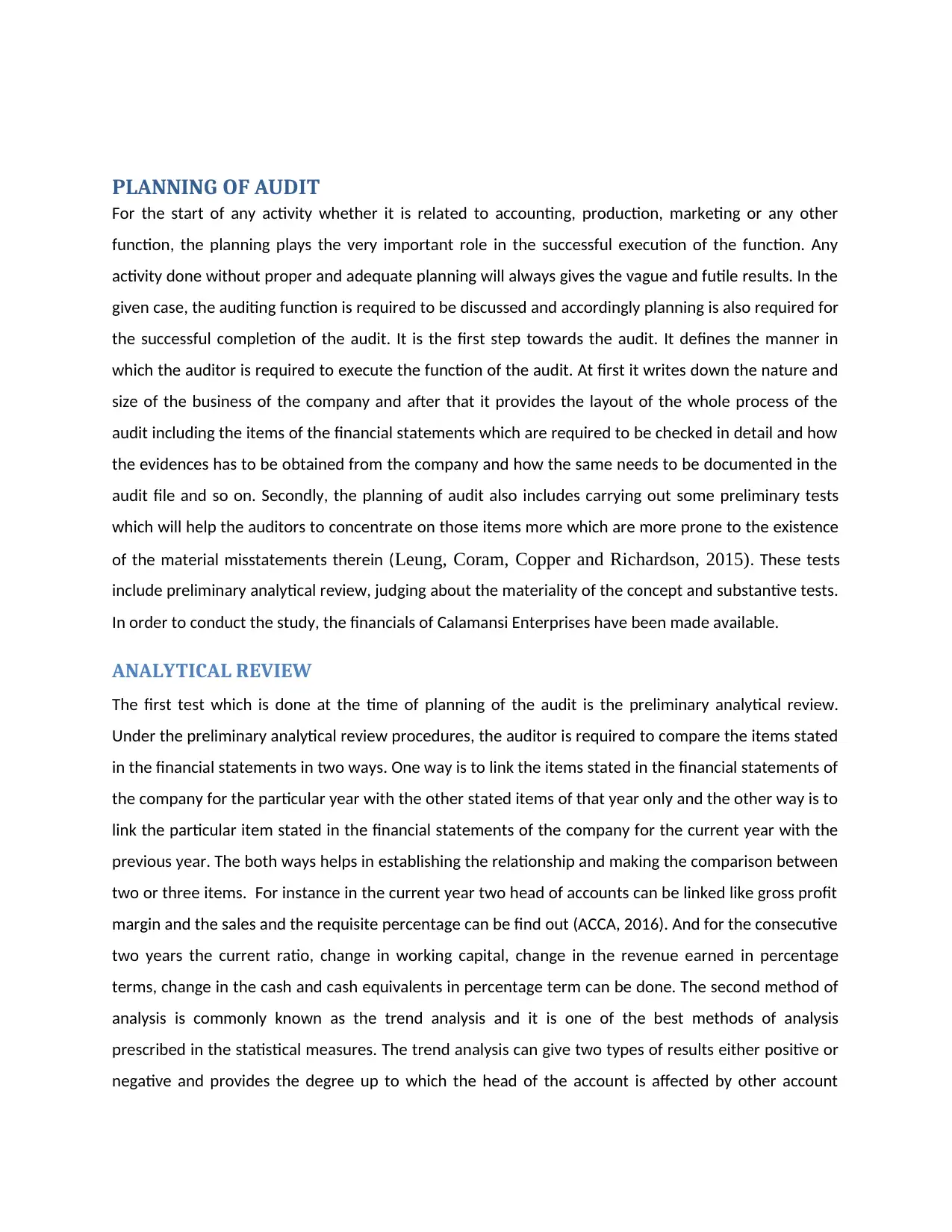
PLANNING OF AUDIT
For the start of any activity whether it is related to accounting, production, marketing or any other
function, the planning plays the very important role in the successful execution of the function. Any
activity done without proper and adequate planning will always gives the vague and futile results. In the
given case, the auditing function is required to be discussed and accordingly planning is also required for
the successful completion of the audit. It is the first step towards the audit. It defines the manner in
which the auditor is required to execute the function of the audit. At first it writes down the nature and
size of the business of the company and after that it provides the layout of the whole process of the
audit including the items of the financial statements which are required to be checked in detail and how
the evidences has to be obtained from the company and how the same needs to be documented in the
audit file and so on. Secondly, the planning of audit also includes carrying out some preliminary tests
which will help the auditors to concentrate on those items more which are more prone to the existence
of the material misstatements therein (Leung, Coram, Copper and Richardson, 2015). These tests
include preliminary analytical review, judging about the materiality of the concept and substantive tests.
In order to conduct the study, the financials of Calamansi Enterprises have been made available.
ANALYTICAL REVIEW
The first test which is done at the time of planning of the audit is the preliminary analytical review.
Under the preliminary analytical review procedures, the auditor is required to compare the items stated
in the financial statements in two ways. One way is to link the items stated in the financial statements of
the company for the particular year with the other stated items of that year only and the other way is to
link the particular item stated in the financial statements of the company for the current year with the
previous year. The both ways helps in establishing the relationship and making the comparison between
two or three items. For instance in the current year two head of accounts can be linked like gross profit
margin and the sales and the requisite percentage can be find out (ACCA, 2016). And for the consecutive
two years the current ratio, change in working capital, change in the revenue earned in percentage
terms, change in the cash and cash equivalents in percentage term can be done. The second method of
analysis is commonly known as the trend analysis and it is one of the best methods of analysis
prescribed in the statistical measures. The trend analysis can give two types of results either positive or
negative and provides the degree up to which the head of the account is affected by other account
For the start of any activity whether it is related to accounting, production, marketing or any other
function, the planning plays the very important role in the successful execution of the function. Any
activity done without proper and adequate planning will always gives the vague and futile results. In the
given case, the auditing function is required to be discussed and accordingly planning is also required for
the successful completion of the audit. It is the first step towards the audit. It defines the manner in
which the auditor is required to execute the function of the audit. At first it writes down the nature and
size of the business of the company and after that it provides the layout of the whole process of the
audit including the items of the financial statements which are required to be checked in detail and how
the evidences has to be obtained from the company and how the same needs to be documented in the
audit file and so on. Secondly, the planning of audit also includes carrying out some preliminary tests
which will help the auditors to concentrate on those items more which are more prone to the existence
of the material misstatements therein (Leung, Coram, Copper and Richardson, 2015). These tests
include preliminary analytical review, judging about the materiality of the concept and substantive tests.
In order to conduct the study, the financials of Calamansi Enterprises have been made available.
ANALYTICAL REVIEW
The first test which is done at the time of planning of the audit is the preliminary analytical review.
Under the preliminary analytical review procedures, the auditor is required to compare the items stated
in the financial statements in two ways. One way is to link the items stated in the financial statements of
the company for the particular year with the other stated items of that year only and the other way is to
link the particular item stated in the financial statements of the company for the current year with the
previous year. The both ways helps in establishing the relationship and making the comparison between
two or three items. For instance in the current year two head of accounts can be linked like gross profit
margin and the sales and the requisite percentage can be find out (ACCA, 2016). And for the consecutive
two years the current ratio, change in working capital, change in the revenue earned in percentage
terms, change in the cash and cash equivalents in percentage term can be done. The second method of
analysis is commonly known as the trend analysis and it is one of the best methods of analysis
prescribed in the statistical measures. The trend analysis can give two types of results either positive or
negative and provides the degree up to which the head of the account is affected by other account
Paraphrase This Document
Need a fresh take? Get an instant paraphrase of this document with our AI Paraphraser
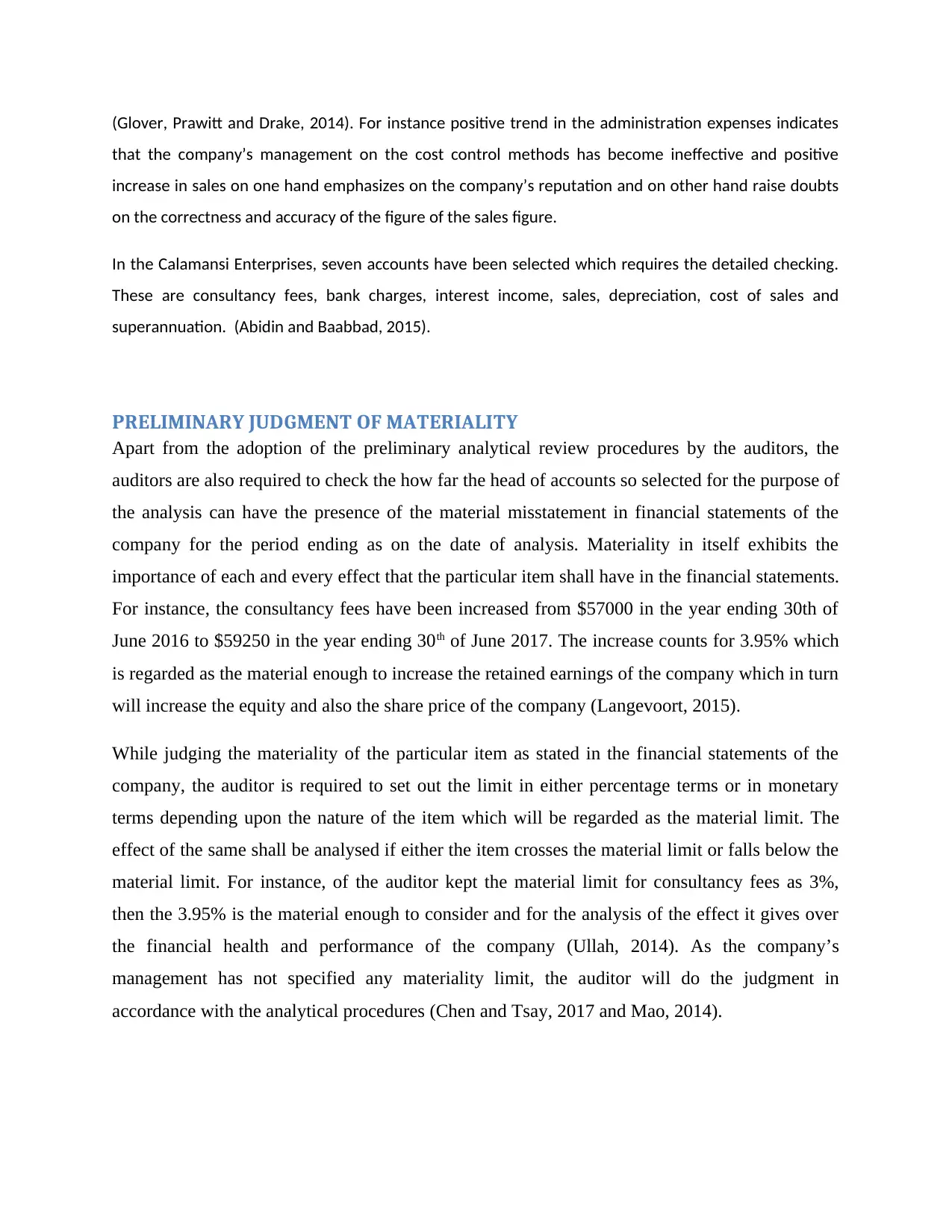
(Glover, Prawitt and Drake, 2014). For instance positive trend in the administration expenses indicates
that the company’s management on the cost control methods has become ineffective and positive
increase in sales on one hand emphasizes on the company’s reputation and on other hand raise doubts
on the correctness and accuracy of the figure of the sales figure.
In the Calamansi Enterprises, seven accounts have been selected which requires the detailed checking.
These are consultancy fees, bank charges, interest income, sales, depreciation, cost of sales and
superannuation. (Abidin and Baabbad, 2015).
PRELIMINARY JUDGMENT OF MATERIALITY
Apart from the adoption of the preliminary analytical review procedures by the auditors, the
auditors are also required to check the how far the head of accounts so selected for the purpose of
the analysis can have the presence of the material misstatement in financial statements of the
company for the period ending as on the date of analysis. Materiality in itself exhibits the
importance of each and every effect that the particular item shall have in the financial statements.
For instance, the consultancy fees have been increased from $57000 in the year ending 30th of
June 2016 to $59250 in the year ending 30th of June 2017. The increase counts for 3.95% which
is regarded as the material enough to increase the retained earnings of the company which in turn
will increase the equity and also the share price of the company (Langevoort, 2015).
While judging the materiality of the particular item as stated in the financial statements of the
company, the auditor is required to set out the limit in either percentage terms or in monetary
terms depending upon the nature of the item which will be regarded as the material limit. The
effect of the same shall be analysed if either the item crosses the material limit or falls below the
material limit. For instance, of the auditor kept the material limit for consultancy fees as 3%,
then the 3.95% is the material enough to consider and for the analysis of the effect it gives over
the financial health and performance of the company (Ullah, 2014). As the company’s
management has not specified any materiality limit, the auditor will do the judgment in
accordance with the analytical procedures (Chen and Tsay, 2017 and Mao, 2014).
that the company’s management on the cost control methods has become ineffective and positive
increase in sales on one hand emphasizes on the company’s reputation and on other hand raise doubts
on the correctness and accuracy of the figure of the sales figure.
In the Calamansi Enterprises, seven accounts have been selected which requires the detailed checking.
These are consultancy fees, bank charges, interest income, sales, depreciation, cost of sales and
superannuation. (Abidin and Baabbad, 2015).
PRELIMINARY JUDGMENT OF MATERIALITY
Apart from the adoption of the preliminary analytical review procedures by the auditors, the
auditors are also required to check the how far the head of accounts so selected for the purpose of
the analysis can have the presence of the material misstatement in financial statements of the
company for the period ending as on the date of analysis. Materiality in itself exhibits the
importance of each and every effect that the particular item shall have in the financial statements.
For instance, the consultancy fees have been increased from $57000 in the year ending 30th of
June 2016 to $59250 in the year ending 30th of June 2017. The increase counts for 3.95% which
is regarded as the material enough to increase the retained earnings of the company which in turn
will increase the equity and also the share price of the company (Langevoort, 2015).
While judging the materiality of the particular item as stated in the financial statements of the
company, the auditor is required to set out the limit in either percentage terms or in monetary
terms depending upon the nature of the item which will be regarded as the material limit. The
effect of the same shall be analysed if either the item crosses the material limit or falls below the
material limit. For instance, of the auditor kept the material limit for consultancy fees as 3%,
then the 3.95% is the material enough to consider and for the analysis of the effect it gives over
the financial health and performance of the company (Ullah, 2014). As the company’s
management has not specified any materiality limit, the auditor will do the judgment in
accordance with the analytical procedures (Chen and Tsay, 2017 and Mao, 2014).
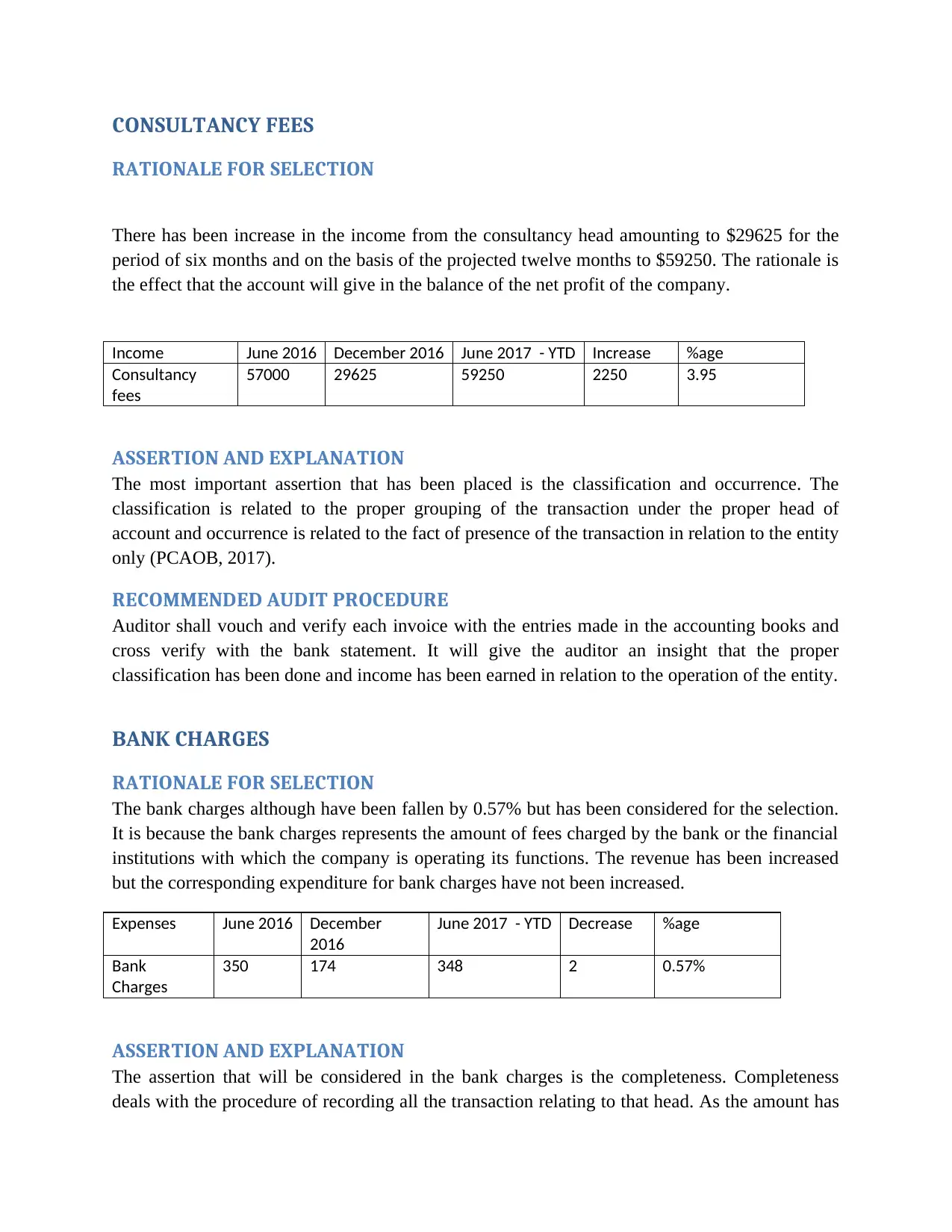
CONSULTANCY FEES
RATIONALE FOR SELECTION
There has been increase in the income from the consultancy head amounting to $29625 for the
period of six months and on the basis of the projected twelve months to $59250. The rationale is
the effect that the account will give in the balance of the net profit of the company.
Income June 2016 December 2016 June 2017 - YTD Increase %age
Consultancy
fees
57000 29625 59250 2250 3.95
ASSERTION AND EXPLANATION
The most important assertion that has been placed is the classification and occurrence. The
classification is related to the proper grouping of the transaction under the proper head of
account and occurrence is related to the fact of presence of the transaction in relation to the entity
only (PCAOB, 2017).
RECOMMENDED AUDIT PROCEDURE
Auditor shall vouch and verify each invoice with the entries made in the accounting books and
cross verify with the bank statement. It will give the auditor an insight that the proper
classification has been done and income has been earned in relation to the operation of the entity.
BANK CHARGES
RATIONALE FOR SELECTION
The bank charges although have been fallen by 0.57% but has been considered for the selection.
It is because the bank charges represents the amount of fees charged by the bank or the financial
institutions with which the company is operating its functions. The revenue has been increased
but the corresponding expenditure for bank charges have not been increased.
Expenses June 2016 December
2016
June 2017 - YTD Decrease %age
Bank
Charges
350 174 348 2 0.57%
ASSERTION AND EXPLANATION
The assertion that will be considered in the bank charges is the completeness. Completeness
deals with the procedure of recording all the transaction relating to that head. As the amount has
RATIONALE FOR SELECTION
There has been increase in the income from the consultancy head amounting to $29625 for the
period of six months and on the basis of the projected twelve months to $59250. The rationale is
the effect that the account will give in the balance of the net profit of the company.
Income June 2016 December 2016 June 2017 - YTD Increase %age
Consultancy
fees
57000 29625 59250 2250 3.95
ASSERTION AND EXPLANATION
The most important assertion that has been placed is the classification and occurrence. The
classification is related to the proper grouping of the transaction under the proper head of
account and occurrence is related to the fact of presence of the transaction in relation to the entity
only (PCAOB, 2017).
RECOMMENDED AUDIT PROCEDURE
Auditor shall vouch and verify each invoice with the entries made in the accounting books and
cross verify with the bank statement. It will give the auditor an insight that the proper
classification has been done and income has been earned in relation to the operation of the entity.
BANK CHARGES
RATIONALE FOR SELECTION
The bank charges although have been fallen by 0.57% but has been considered for the selection.
It is because the bank charges represents the amount of fees charged by the bank or the financial
institutions with which the company is operating its functions. The revenue has been increased
but the corresponding expenditure for bank charges have not been increased.
Expenses June 2016 December
2016
June 2017 - YTD Decrease %age
Bank
Charges
350 174 348 2 0.57%
ASSERTION AND EXPLANATION
The assertion that will be considered in the bank charges is the completeness. Completeness
deals with the procedure of recording all the transaction relating to that head. As the amount has
⊘ This is a preview!⊘
Do you want full access?
Subscribe today to unlock all pages.

Trusted by 1+ million students worldwide
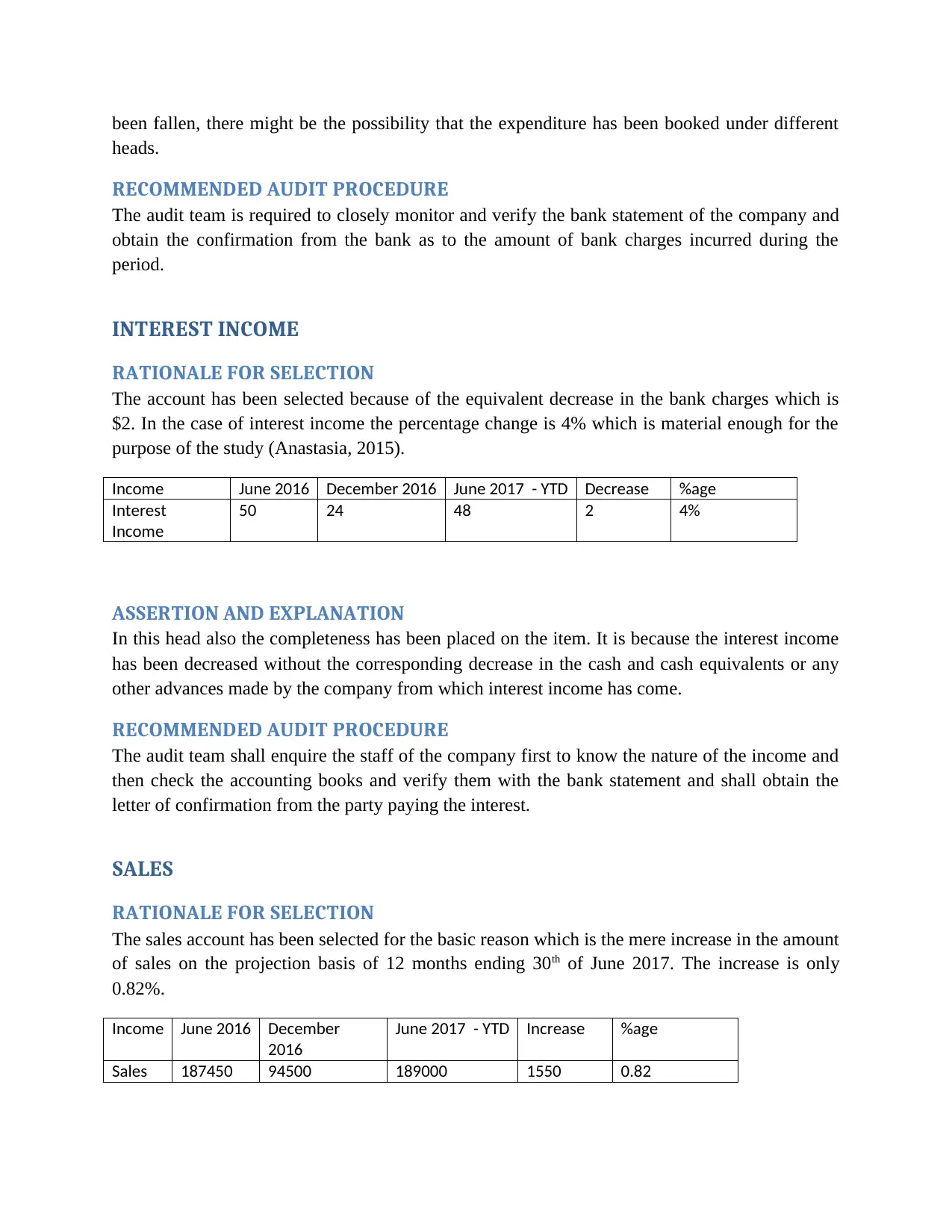
been fallen, there might be the possibility that the expenditure has been booked under different
heads.
RECOMMENDED AUDIT PROCEDURE
The audit team is required to closely monitor and verify the bank statement of the company and
obtain the confirmation from the bank as to the amount of bank charges incurred during the
period.
INTEREST INCOME
RATIONALE FOR SELECTION
The account has been selected because of the equivalent decrease in the bank charges which is
$2. In the case of interest income the percentage change is 4% which is material enough for the
purpose of the study (Anastasia, 2015).
Income June 2016 December 2016 June 2017 - YTD Decrease %age
Interest
Income
50 24 48 2 4%
ASSERTION AND EXPLANATION
In this head also the completeness has been placed on the item. It is because the interest income
has been decreased without the corresponding decrease in the cash and cash equivalents or any
other advances made by the company from which interest income has come.
RECOMMENDED AUDIT PROCEDURE
The audit team shall enquire the staff of the company first to know the nature of the income and
then check the accounting books and verify them with the bank statement and shall obtain the
letter of confirmation from the party paying the interest.
SALES
RATIONALE FOR SELECTION
The sales account has been selected for the basic reason which is the mere increase in the amount
of sales on the projection basis of 12 months ending 30th of June 2017. The increase is only
0.82%.
Income June 2016 December
2016
June 2017 - YTD Increase %age
Sales 187450 94500 189000 1550 0.82
heads.
RECOMMENDED AUDIT PROCEDURE
The audit team is required to closely monitor and verify the bank statement of the company and
obtain the confirmation from the bank as to the amount of bank charges incurred during the
period.
INTEREST INCOME
RATIONALE FOR SELECTION
The account has been selected because of the equivalent decrease in the bank charges which is
$2. In the case of interest income the percentage change is 4% which is material enough for the
purpose of the study (Anastasia, 2015).
Income June 2016 December 2016 June 2017 - YTD Decrease %age
Interest
Income
50 24 48 2 4%
ASSERTION AND EXPLANATION
In this head also the completeness has been placed on the item. It is because the interest income
has been decreased without the corresponding decrease in the cash and cash equivalents or any
other advances made by the company from which interest income has come.
RECOMMENDED AUDIT PROCEDURE
The audit team shall enquire the staff of the company first to know the nature of the income and
then check the accounting books and verify them with the bank statement and shall obtain the
letter of confirmation from the party paying the interest.
SALES
RATIONALE FOR SELECTION
The sales account has been selected for the basic reason which is the mere increase in the amount
of sales on the projection basis of 12 months ending 30th of June 2017. The increase is only
0.82%.
Income June 2016 December
2016
June 2017 - YTD Increase %age
Sales 187450 94500 189000 1550 0.82
Paraphrase This Document
Need a fresh take? Get an instant paraphrase of this document with our AI Paraphraser
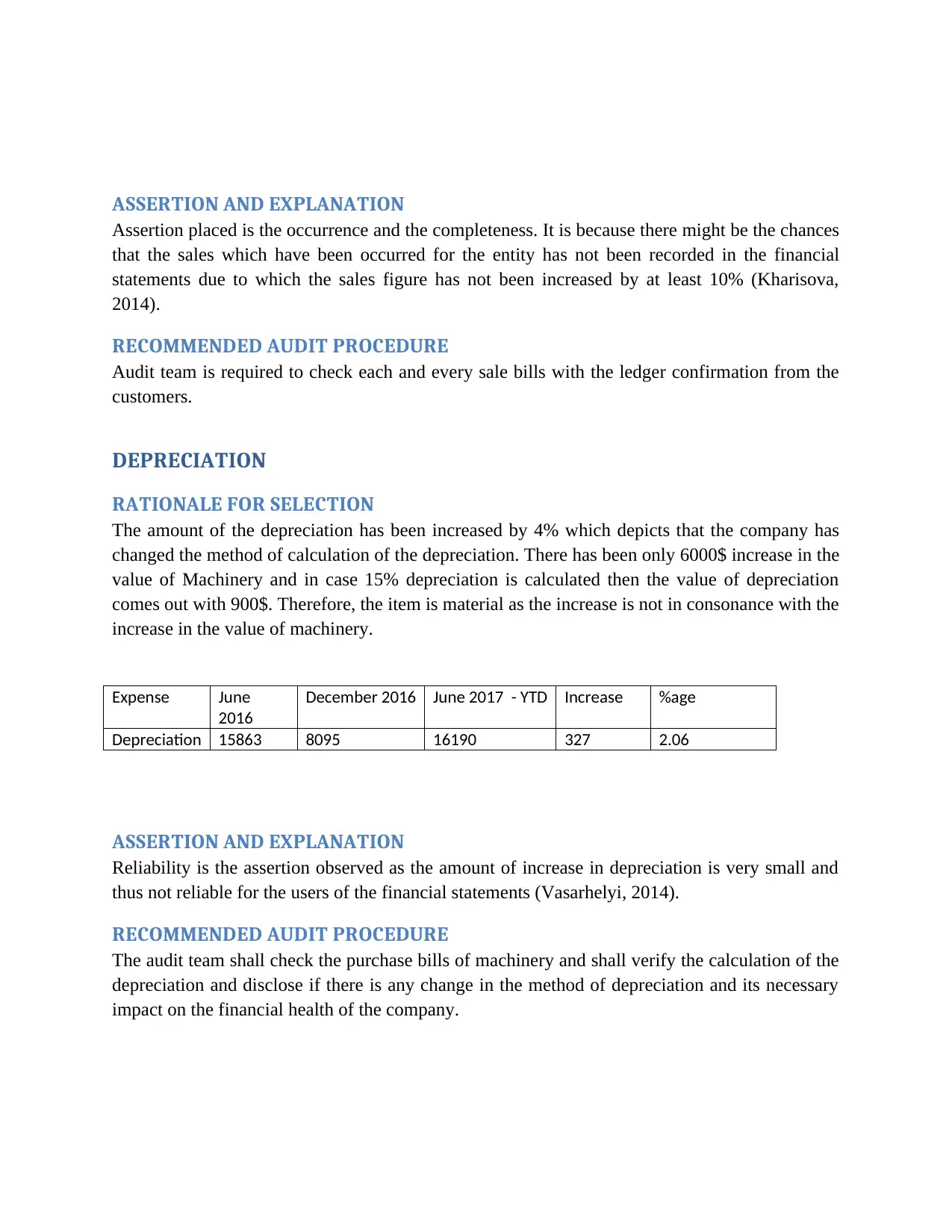
ASSERTION AND EXPLANATION
Assertion placed is the occurrence and the completeness. It is because there might be the chances
that the sales which have been occurred for the entity has not been recorded in the financial
statements due to which the sales figure has not been increased by at least 10% (Kharisova,
2014).
RECOMMENDED AUDIT PROCEDURE
Audit team is required to check each and every sale bills with the ledger confirmation from the
customers.
DEPRECIATION
RATIONALE FOR SELECTION
The amount of the depreciation has been increased by 4% which depicts that the company has
changed the method of calculation of the depreciation. There has been only 6000$ increase in the
value of Machinery and in case 15% depreciation is calculated then the value of depreciation
comes out with 900$. Therefore, the item is material as the increase is not in consonance with the
increase in the value of machinery.
Expense June
2016
December 2016 June 2017 - YTD Increase %age
Depreciation 15863 8095 16190 327 2.06
ASSERTION AND EXPLANATION
Reliability is the assertion observed as the amount of increase in depreciation is very small and
thus not reliable for the users of the financial statements (Vasarhelyi, 2014).
RECOMMENDED AUDIT PROCEDURE
The audit team shall check the purchase bills of machinery and shall verify the calculation of the
depreciation and disclose if there is any change in the method of depreciation and its necessary
impact on the financial health of the company.
Assertion placed is the occurrence and the completeness. It is because there might be the chances
that the sales which have been occurred for the entity has not been recorded in the financial
statements due to which the sales figure has not been increased by at least 10% (Kharisova,
2014).
RECOMMENDED AUDIT PROCEDURE
Audit team is required to check each and every sale bills with the ledger confirmation from the
customers.
DEPRECIATION
RATIONALE FOR SELECTION
The amount of the depreciation has been increased by 4% which depicts that the company has
changed the method of calculation of the depreciation. There has been only 6000$ increase in the
value of Machinery and in case 15% depreciation is calculated then the value of depreciation
comes out with 900$. Therefore, the item is material as the increase is not in consonance with the
increase in the value of machinery.
Expense June
2016
December 2016 June 2017 - YTD Increase %age
Depreciation 15863 8095 16190 327 2.06
ASSERTION AND EXPLANATION
Reliability is the assertion observed as the amount of increase in depreciation is very small and
thus not reliable for the users of the financial statements (Vasarhelyi, 2014).
RECOMMENDED AUDIT PROCEDURE
The audit team shall check the purchase bills of machinery and shall verify the calculation of the
depreciation and disclose if there is any change in the method of depreciation and its necessary
impact on the financial health of the company.
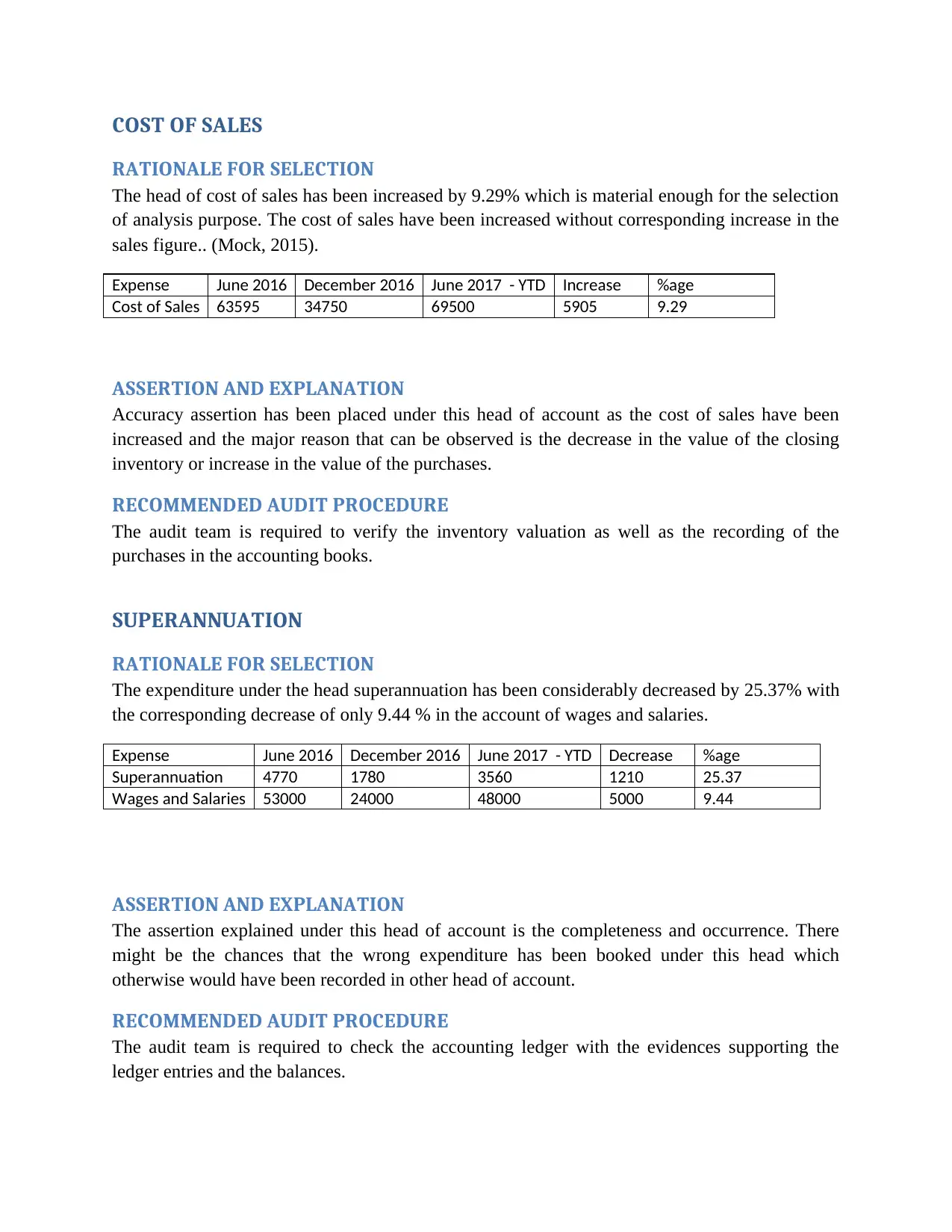
COST OF SALES
RATIONALE FOR SELECTION
The head of cost of sales has been increased by 9.29% which is material enough for the selection
of analysis purpose. The cost of sales have been increased without corresponding increase in the
sales figure.. (Mock, 2015).
Expense June 2016 December 2016 June 2017 - YTD Increase %age
Cost of Sales 63595 34750 69500 5905 9.29
ASSERTION AND EXPLANATION
Accuracy assertion has been placed under this head of account as the cost of sales have been
increased and the major reason that can be observed is the decrease in the value of the closing
inventory or increase in the value of the purchases.
RECOMMENDED AUDIT PROCEDURE
The audit team is required to verify the inventory valuation as well as the recording of the
purchases in the accounting books.
SUPERANNUATION
RATIONALE FOR SELECTION
The expenditure under the head superannuation has been considerably decreased by 25.37% with
the corresponding decrease of only 9.44 % in the account of wages and salaries.
Expense June 2016 December 2016 June 2017 - YTD Decrease %age
Superannuation 4770 1780 3560 1210 25.37
Wages and Salaries 53000 24000 48000 5000 9.44
ASSERTION AND EXPLANATION
The assertion explained under this head of account is the completeness and occurrence. There
might be the chances that the wrong expenditure has been booked under this head which
otherwise would have been recorded in other head of account.
RECOMMENDED AUDIT PROCEDURE
The audit team is required to check the accounting ledger with the evidences supporting the
ledger entries and the balances.
RATIONALE FOR SELECTION
The head of cost of sales has been increased by 9.29% which is material enough for the selection
of analysis purpose. The cost of sales have been increased without corresponding increase in the
sales figure.. (Mock, 2015).
Expense June 2016 December 2016 June 2017 - YTD Increase %age
Cost of Sales 63595 34750 69500 5905 9.29
ASSERTION AND EXPLANATION
Accuracy assertion has been placed under this head of account as the cost of sales have been
increased and the major reason that can be observed is the decrease in the value of the closing
inventory or increase in the value of the purchases.
RECOMMENDED AUDIT PROCEDURE
The audit team is required to verify the inventory valuation as well as the recording of the
purchases in the accounting books.
SUPERANNUATION
RATIONALE FOR SELECTION
The expenditure under the head superannuation has been considerably decreased by 25.37% with
the corresponding decrease of only 9.44 % in the account of wages and salaries.
Expense June 2016 December 2016 June 2017 - YTD Decrease %age
Superannuation 4770 1780 3560 1210 25.37
Wages and Salaries 53000 24000 48000 5000 9.44
ASSERTION AND EXPLANATION
The assertion explained under this head of account is the completeness and occurrence. There
might be the chances that the wrong expenditure has been booked under this head which
otherwise would have been recorded in other head of account.
RECOMMENDED AUDIT PROCEDURE
The audit team is required to check the accounting ledger with the evidences supporting the
ledger entries and the balances.
⊘ This is a preview!⊘
Do you want full access?
Subscribe today to unlock all pages.

Trusted by 1+ million students worldwide
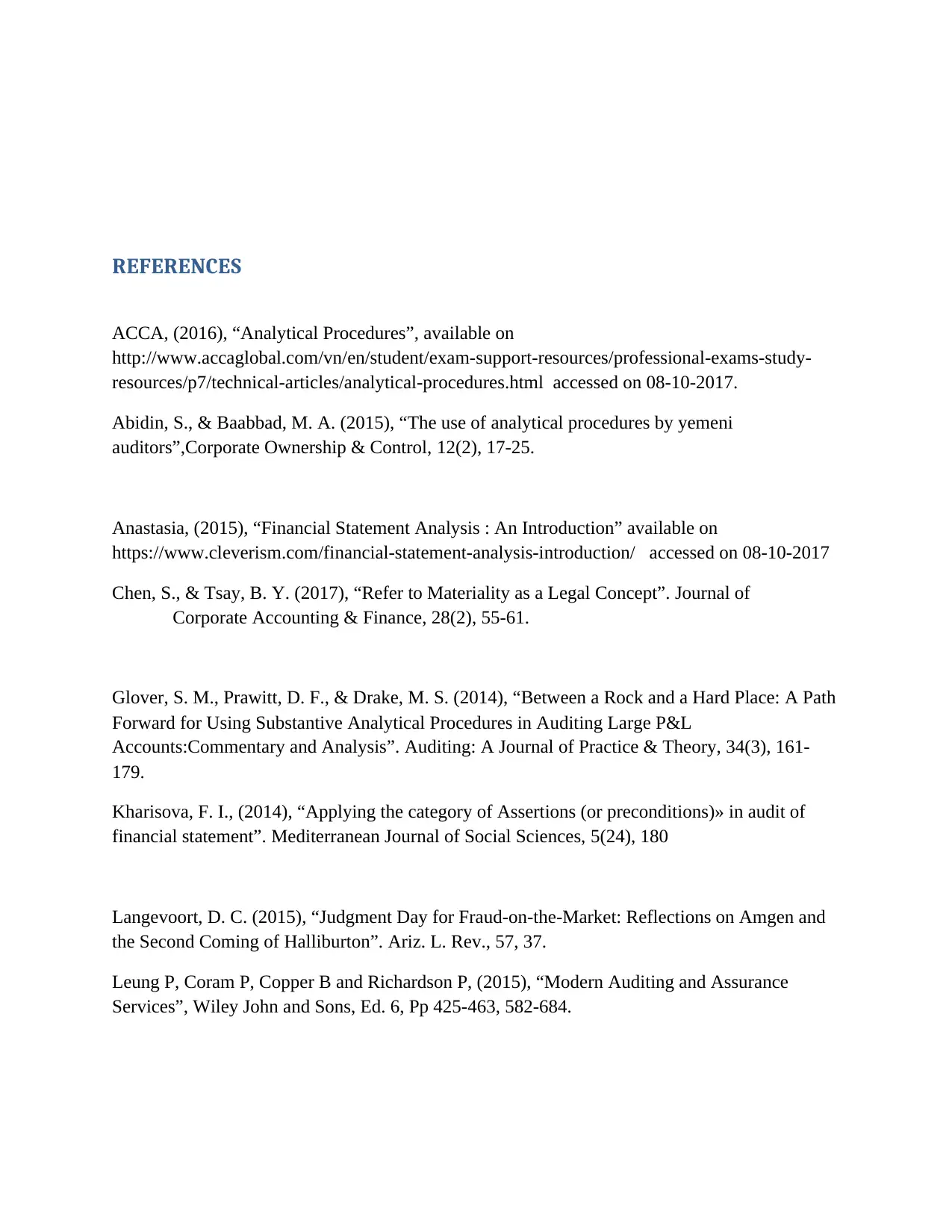
REFERENCES
ACCA, (2016), “Analytical Procedures”, available on
http://www.accaglobal.com/vn/en/student/exam-support-resources/professional-exams-study-
resources/p7/technical-articles/analytical-procedures.html accessed on 08-10-2017.
Abidin, S., & Baabbad, M. A. (2015), “The use of analytical procedures by yemeni
auditors”,Corporate Ownership & Control, 12(2), 17-25.
Anastasia, (2015), “Financial Statement Analysis : An Introduction” available on
https://www.cleverism.com/financial-statement-analysis-introduction/ accessed on 08-10-2017
Chen, S., & Tsay, B. Y. (2017), “Refer to Materiality as a Legal Concept”. Journal of
Corporate Accounting & Finance, 28(2), 55-61.
Glover, S. M., Prawitt, D. F., & Drake, M. S. (2014), “Between a Rock and a Hard Place: A Path
Forward for Using Substantive Analytical Procedures in Auditing Large P&L
Accounts:Commentary and Analysis”. Auditing: A Journal of Practice & Theory, 34(3), 161-
179.
Kharisova, F. I., (2014), “Applying the category of Assertions (or preconditions)» in audit of
financial statement”. Mediterranean Journal of Social Sciences, 5(24), 180
Langevoort, D. C. (2015), “Judgment Day for Fraud-on-the-Market: Reflections on Amgen and
the Second Coming of Halliburton”. Ariz. L. Rev., 57, 37.
Leung P, Coram P, Copper B and Richardson P, (2015), “Modern Auditing and Assurance
Services”, Wiley John and Sons, Ed. 6, Pp 425-463, 582-684.
ACCA, (2016), “Analytical Procedures”, available on
http://www.accaglobal.com/vn/en/student/exam-support-resources/professional-exams-study-
resources/p7/technical-articles/analytical-procedures.html accessed on 08-10-2017.
Abidin, S., & Baabbad, M. A. (2015), “The use of analytical procedures by yemeni
auditors”,Corporate Ownership & Control, 12(2), 17-25.
Anastasia, (2015), “Financial Statement Analysis : An Introduction” available on
https://www.cleverism.com/financial-statement-analysis-introduction/ accessed on 08-10-2017
Chen, S., & Tsay, B. Y. (2017), “Refer to Materiality as a Legal Concept”. Journal of
Corporate Accounting & Finance, 28(2), 55-61.
Glover, S. M., Prawitt, D. F., & Drake, M. S. (2014), “Between a Rock and a Hard Place: A Path
Forward for Using Substantive Analytical Procedures in Auditing Large P&L
Accounts:Commentary and Analysis”. Auditing: A Journal of Practice & Theory, 34(3), 161-
179.
Kharisova, F. I., (2014), “Applying the category of Assertions (or preconditions)» in audit of
financial statement”. Mediterranean Journal of Social Sciences, 5(24), 180
Langevoort, D. C. (2015), “Judgment Day for Fraud-on-the-Market: Reflections on Amgen and
the Second Coming of Halliburton”. Ariz. L. Rev., 57, 37.
Leung P, Coram P, Copper B and Richardson P, (2015), “Modern Auditing and Assurance
Services”, Wiley John and Sons, Ed. 6, Pp 425-463, 582-684.
Paraphrase This Document
Need a fresh take? Get an instant paraphrase of this document with our AI Paraphraser
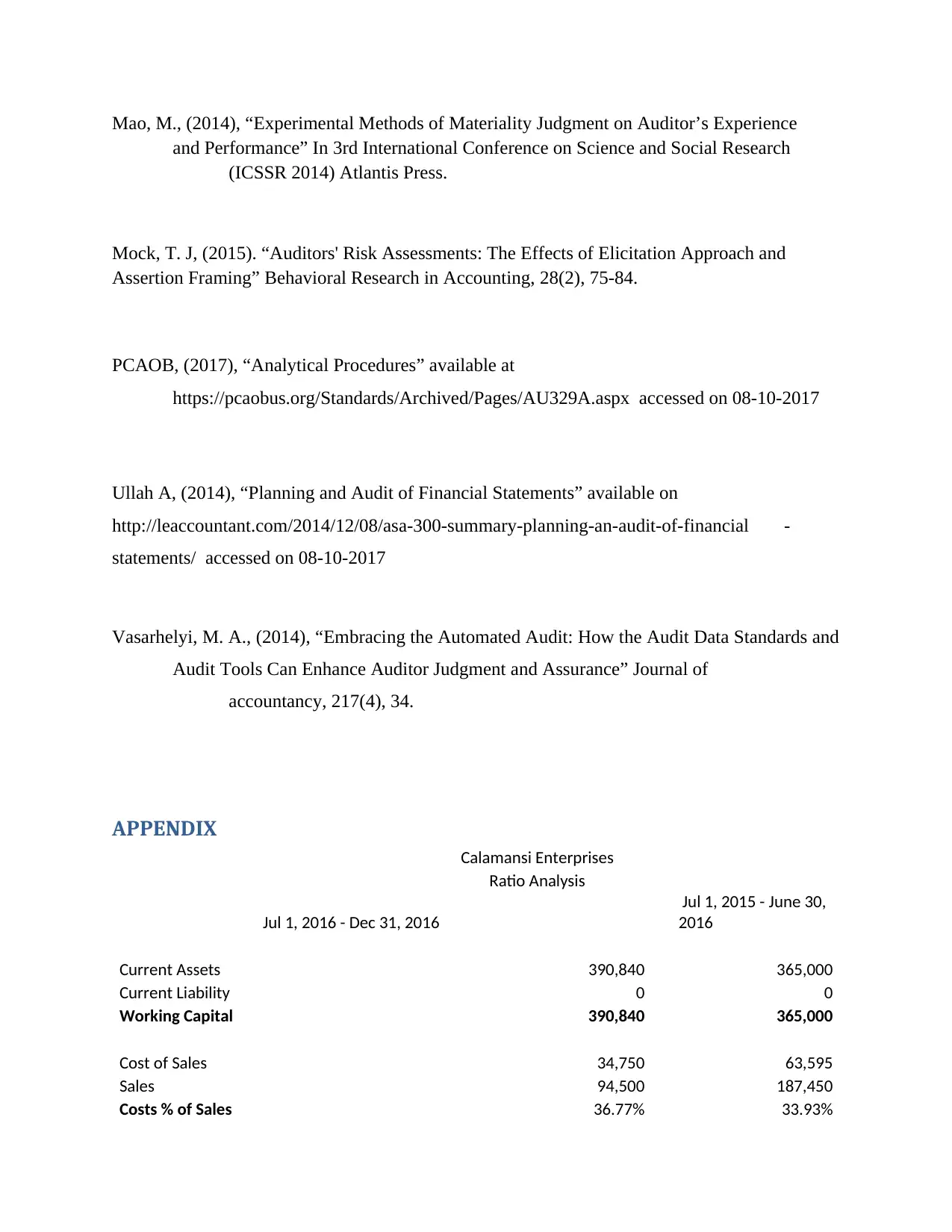
Mao, M., (2014), “Experimental Methods of Materiality Judgment on Auditor’s Experience
and Performance” In 3rd International Conference on Science and Social Research
(ICSSR 2014) Atlantis Press.
Mock, T. J, (2015). “Auditors' Risk Assessments: The Effects of Elicitation Approach and
Assertion Framing” Behavioral Research in Accounting, 28(2), 75-84.
PCAOB, (2017), “Analytical Procedures” available at
https://pcaobus.org/Standards/Archived/Pages/AU329A.aspx accessed on 08-10-2017
Ullah A, (2014), “Planning and Audit of Financial Statements” available on
http://leaccountant.com/2014/12/08/asa-300-summary-planning-an-audit-of-financial -
statements/ accessed on 08-10-2017
Vasarhelyi, M. A., (2014), “Embracing the Automated Audit: How the Audit Data Standards and
Audit Tools Can Enhance Auditor Judgment and Assurance” Journal of
accountancy, 217(4), 34.
APPENDIX
Calamansi Enterprises
Ratio Analysis
Jul 1, 2016 - Dec 31, 2016
Jul 1, 2015 - June 30,
2016
Current Assets 390,840 365,000
Current Liability 0 0
Working Capital 390,840 365,000
Cost of Sales 34,750 63,595
Sales 94,500 187,450
Costs % of Sales 36.77% 33.93%
and Performance” In 3rd International Conference on Science and Social Research
(ICSSR 2014) Atlantis Press.
Mock, T. J, (2015). “Auditors' Risk Assessments: The Effects of Elicitation Approach and
Assertion Framing” Behavioral Research in Accounting, 28(2), 75-84.
PCAOB, (2017), “Analytical Procedures” available at
https://pcaobus.org/Standards/Archived/Pages/AU329A.aspx accessed on 08-10-2017
Ullah A, (2014), “Planning and Audit of Financial Statements” available on
http://leaccountant.com/2014/12/08/asa-300-summary-planning-an-audit-of-financial -
statements/ accessed on 08-10-2017
Vasarhelyi, M. A., (2014), “Embracing the Automated Audit: How the Audit Data Standards and
Audit Tools Can Enhance Auditor Judgment and Assurance” Journal of
accountancy, 217(4), 34.
APPENDIX
Calamansi Enterprises
Ratio Analysis
Jul 1, 2016 - Dec 31, 2016
Jul 1, 2015 - June 30,
2016
Current Assets 390,840 365,000
Current Liability 0 0
Working Capital 390,840 365,000
Cost of Sales 34,750 63,595
Sales 94,500 187,450
Costs % of Sales 36.77% 33.93%
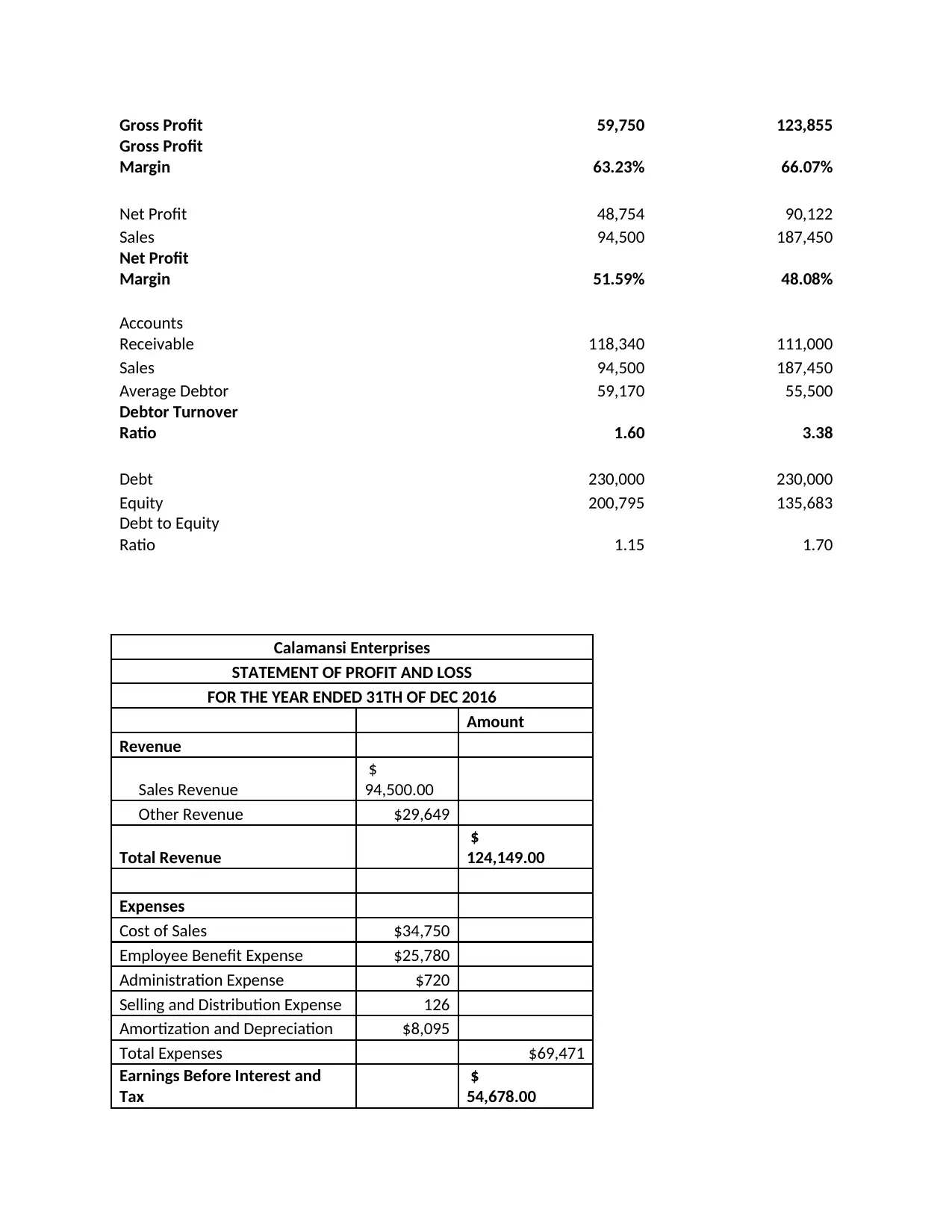
Gross Profit 59,750 123,855
Gross Profit
Margin 63.23% 66.07%
Net Profit 48,754 90,122
Sales 94,500 187,450
Net Profit
Margin 51.59% 48.08%
Accounts
Receivable 118,340 111,000
Sales 94,500 187,450
Average Debtor 59,170 55,500
Debtor Turnover
Ratio 1.60 3.38
Debt 230,000 230,000
Equity 200,795 135,683
Debt to Equity
Ratio 1.15 1.70
Calamansi Enterprises
STATEMENT OF PROFIT AND LOSS
FOR THE YEAR ENDED 31TH OF DEC 2016
Amount
Revenue
Sales Revenue
$
94,500.00
Other Revenue $29,649
Total Revenue
$
124,149.00
Expenses
Cost of Sales $34,750
Employee Benefit Expense $25,780
Administration Expense $720
Selling and Distribution Expense 126
Amortization and Depreciation $8,095
Total Expenses $69,471
Earnings Before Interest and
Tax
$
54,678.00
Gross Profit
Margin 63.23% 66.07%
Net Profit 48,754 90,122
Sales 94,500 187,450
Net Profit
Margin 51.59% 48.08%
Accounts
Receivable 118,340 111,000
Sales 94,500 187,450
Average Debtor 59,170 55,500
Debtor Turnover
Ratio 1.60 3.38
Debt 230,000 230,000
Equity 200,795 135,683
Debt to Equity
Ratio 1.15 1.70
Calamansi Enterprises
STATEMENT OF PROFIT AND LOSS
FOR THE YEAR ENDED 31TH OF DEC 2016
Amount
Revenue
Sales Revenue
$
94,500.00
Other Revenue $29,649
Total Revenue
$
124,149.00
Expenses
Cost of Sales $34,750
Employee Benefit Expense $25,780
Administration Expense $720
Selling and Distribution Expense 126
Amortization and Depreciation $8,095
Total Expenses $69,471
Earnings Before Interest and
Tax
$
54,678.00
⊘ This is a preview!⊘
Do you want full access?
Subscribe today to unlock all pages.

Trusted by 1+ million students worldwide
1 out of 16
Related Documents
Your All-in-One AI-Powered Toolkit for Academic Success.
+13062052269
info@desklib.com
Available 24*7 on WhatsApp / Email
![[object Object]](/_next/static/media/star-bottom.7253800d.svg)
Unlock your academic potential
Copyright © 2020–2025 A2Z Services. All Rights Reserved. Developed and managed by ZUCOL.





